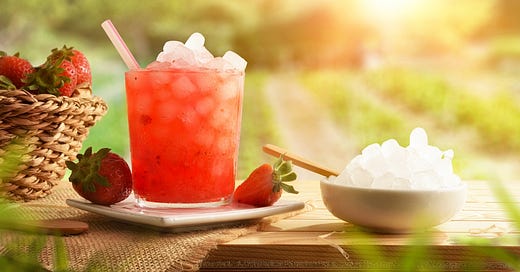All living and non-living materials are a unique combination of chemicals. While most chemicals are toxic for human consumption, there are thousands that are not—including chemicals that contribute to flavor. For example, biting into a strawberry, one will taste upwards of hundreds of different chemicals. Each of these flavor chemicals can be described in one to two words (like juicy, green, fruity, seedy, etc.). The unique combination and amounts of these different flavor chemicals make up the differences between different strawberry types (i.e. ripe, unripe, Wild, June-bearing, etc.).
Just as in nature, “natural flavors” contain hundreds of different flavor chemicals that are in unique combinations and levels. These flavor chemicals are extracted from natural sources like plants, fruits, vegetables, spices, herbs, edible barks, leaves, roots, buds, essential oils, dairy products, fermented products, meat, seafood, poultry, or eggs. Once these flavor chemicals are extracted, Flavor Chemists (yes, that is a profession!) combine these chemicals back together to create a natural flavor. In the example of the strawberry, Flavor Chemists might want to create a ripe, sweet natural strawberry flavor. They would then combine flavor chemicals that have a description of “ripe” and “sweet” to create a natural strawberry flavor that is similar (but much faster and more efficient) than what Mother Nature could do. The flavor chemicals used in this new strawberry flavor can be from an actual strawberry but could also be from the other natural sources listed above. The exact chemicals and their respective amounts are the intellectual property of the flavor company producing the natural flavor and considered proprietary. This does not imply that there is anything hidden or unsafe in a natural flavor. All flavor chemicals go through rigorous safety processes before they are considered acceptable to use in a natural flavor.
Natural flavor chemicals are so potent that they need to be mixed in a solvent like water, alcohol (ethanol), triethyl citrate, and/or propylene glycol so that they are diluted to safe and effective levels. In fact, these flavor chemicals are diluted so much that the solvent can make up to 80% of a natural flavor. While water and alcohol are natural, triethyl citrate and propylene glycol can be considered processed. Triethyl citrate is created via a chemical reaction when naturally occurring alcohol (ethanol) and citric acid are combined together. Propylene glycol is a highly processed chemical derived from either petroleum or biodiesel. Despite the inherent “unnatural-ness” of propylene glycol, flavor companies are allowed to use it in natural flavors.
Opponents use this fact to state that natural flavors are considered 80% artificial. Although it is a stretch to consider propylene glycol natural, the other solvents (water, ethanol, and even triethyl citrate to a degree) are natural. Although the consumer would have no knowledge of what solvent makes up the natural flavor, the company selling the food or beverage product would know the solvent that makes up the natural flavor.
Food and beverage products that have certain claims (especially claims from third parties like Non-GMO Project Verified and the Gluten Free Certification Organization) require their products to contain natural flavors that are in accordance with their high standards. These organizations take a closer look at the solvents and other chemicals that make up the natural flavors to ensure that they follow the claims. Products that are not certified by third party regulatory agencies may or may not have natural flavors that follow the claims that they might possess.
Do you buy foods and beverages that contain natural flavors? If not, why?




